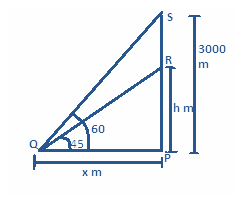
An aeroplane when $3000$ m high passes vertically above another aeroplane at an instance when their angles of elevation at the same observation point are $60^\circ $ and $45^\circ $. Find how many meters higher is this one than the other aeroplane.
A)$1350$ m B) $1268$ m C) $1000$ m D) $1160$ m
Answer
582k+ views
Hint: Here, the height of the first aeroplane is given and we have to find how high this aeroplane is from the airplane whose height is not known. First find the distance of the observation point from the aeroplanes using the angle of elevation and the height given by using the formula, $\tan \theta = \dfrac{{\text{P}}}{{\text{B}}}$. Then find the height of the other aeroplane by using the same formula. Then subtract this height from the given height and you’ll get the answer.
Complete step-by-step answer:
Given, the height of first aeroplane PS =$3000$ m whose angle of elevation from the observation point is $\angle {\text{PQS = 60}}^\circ $ .The second aeroplane has height PR= h m and the angle of elevation from observation point is $\angle {\text{PQR = 45}}^\circ $.We have to find the height of second plane from first aeroplane RS.

Let the distance of the observation point from both the planes PQ be x m. Then in right angled triangle SPQ,
$ \Rightarrow \tan \theta = \dfrac{{{\text{PS}}}}{{{\text{PQ}}}}$ $\left[ {{\text{as tan}}\theta {\text{ = }}\dfrac{{\text{P}}}{{\text{B}}}} \right]$
On putting the given values, we get-
$ \Rightarrow \tan {60^ \circ } = \dfrac{{3000}}{{\text{x}}} \Rightarrow \sqrt 3 = \dfrac{{3000}}{{\text{x}}}$
On rationalizing and solving for x, we get-
$ \Rightarrow {\text{x = }}\dfrac{{3000 \times \sqrt 3 }}{{\sqrt 3 \times \sqrt 3 }} = \dfrac{{3000\sqrt 3 }}{3} = 1000\sqrt 3 $ m
Now we need to find the height of the second aeroplane. So in right angled triangle RPQ,
$ \Rightarrow \tan {45^ \circ } = \dfrac{{{\text{PR}}}}{{{\text{PQ}}}}$ $ \Rightarrow 1 = \dfrac{{\text{h}}}{{\text{x}}} \Rightarrow {\text{h = x}}$
Since we know the value of x, we put it in the equation-
$ \Rightarrow {\text{h = 1000}} \times {\text{1}}{\text{.732 = 1732}}$ m
Now we have to find the height of the second aeroplane from first. So,
$ \Rightarrow {\text{RS = PS - PR}}$
On putting the given values, we get-
$ \Rightarrow {\text{RS = 3000 - 1732 = 1268}}$ m
Hence the first aeroplane is $1268$ m high from the second aeroplane.
Note: To solve this type of question, we have to draw the correct diagram. Hence it is important to read the statement carefully. In this question, the formula of $\tan \theta $ is used because one quantity is given and we have to find the other quantity and angle is also given. Here, P stands for perpendicular and B stands for base of triangle.
Complete step-by-step answer:
Given, the height of first aeroplane PS =$3000$ m whose angle of elevation from the observation point is $\angle {\text{PQS = 60}}^\circ $ .The second aeroplane has height PR= h m and the angle of elevation from observation point is $\angle {\text{PQR = 45}}^\circ $.We have to find the height of second plane from first aeroplane RS.

Let the distance of the observation point from both the planes PQ be x m. Then in right angled triangle SPQ,
$ \Rightarrow \tan \theta = \dfrac{{{\text{PS}}}}{{{\text{PQ}}}}$ $\left[ {{\text{as tan}}\theta {\text{ = }}\dfrac{{\text{P}}}{{\text{B}}}} \right]$
On putting the given values, we get-
$ \Rightarrow \tan {60^ \circ } = \dfrac{{3000}}{{\text{x}}} \Rightarrow \sqrt 3 = \dfrac{{3000}}{{\text{x}}}$
On rationalizing and solving for x, we get-
$ \Rightarrow {\text{x = }}\dfrac{{3000 \times \sqrt 3 }}{{\sqrt 3 \times \sqrt 3 }} = \dfrac{{3000\sqrt 3 }}{3} = 1000\sqrt 3 $ m
Now we need to find the height of the second aeroplane. So in right angled triangle RPQ,
$ \Rightarrow \tan {45^ \circ } = \dfrac{{{\text{PR}}}}{{{\text{PQ}}}}$ $ \Rightarrow 1 = \dfrac{{\text{h}}}{{\text{x}}} \Rightarrow {\text{h = x}}$
Since we know the value of x, we put it in the equation-
$ \Rightarrow {\text{h = 1000}} \times {\text{1}}{\text{.732 = 1732}}$ m
Now we have to find the height of the second aeroplane from first. So,
$ \Rightarrow {\text{RS = PS - PR}}$
On putting the given values, we get-
$ \Rightarrow {\text{RS = 3000 - 1732 = 1268}}$ m
Hence the first aeroplane is $1268$ m high from the second aeroplane.
Note: To solve this type of question, we have to draw the correct diagram. Hence it is important to read the statement carefully. In this question, the formula of $\tan \theta $ is used because one quantity is given and we have to find the other quantity and angle is also given. Here, P stands for perpendicular and B stands for base of triangle.
Recently Updated Pages
Why are manures considered better than fertilizers class 11 biology CBSE

Find the coordinates of the midpoint of the line segment class 11 maths CBSE

Distinguish between static friction limiting friction class 11 physics CBSE

The Chairman of the constituent Assembly was A Jawaharlal class 11 social science CBSE

The first National Commission on Labour NCL submitted class 11 social science CBSE

Number of all subshell of n + l 7 is A 4 B 5 C 6 D class 11 chemistry CBSE

Trending doubts
Differentiate between an exothermic and an endothermic class 11 chemistry CBSE

10 examples of friction in our daily life

One Metric ton is equal to kg A 10000 B 1000 C 100 class 11 physics CBSE

Difference Between Prokaryotic Cells and Eukaryotic Cells

1 Quintal is equal to a 110 kg b 10 kg c 100kg d 1000 class 11 physics CBSE

State the laws of reflection of light




